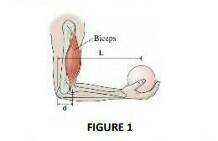
Physics, 19.11.2020 15:40 jamarstand
Figure 1 above shows an athlete's forearm holding a steel ball. The forearm is supported by a contraction of the biceps muscle, which causes a torque around the elbow. Assuming that the tension in the biceps acts along the vertical direction given by gravity and the centre of gravity of the forearm is half of L. What tension must the biceps muscle exert to hold the forearm at the position shown? Sketch and label your free body diagram. (Let L= 33.5 cm, d = 3.8 cm, mass of steel ball = 280 g, mass of the forearm = 2.5 kg)


Answers: 3


Other questions on the subject: Physics


Physics, 22.06.2019 10:00, ceasar6071
Students design a model roller-coaster track. they place a rubber ball at the highest point on the track and let it go. the ball rolls along the track pulled only by the force of gravity. eventually, it comes to a stop. which change to the design will result in the ball moving the greatest distance?
Answers: 1

Physics, 22.06.2019 12:20, ginachuquiano450
Aball with a mass of 275 g is dropped from rest, hits the floor and rebounds upward. if the ball hits the floor with a speed of 2.40 m/s and rebounds with a speed of 1.70 m/s, determine the following. (a) magnitude of the change in the ball's momentum (let up be in the positive direction.)
Answers: 1
You know the right answer?
Figure 1 above shows an athlete's forearm holding a steel ball. The forearm is supported by a contra...
Questions in other subjects:













